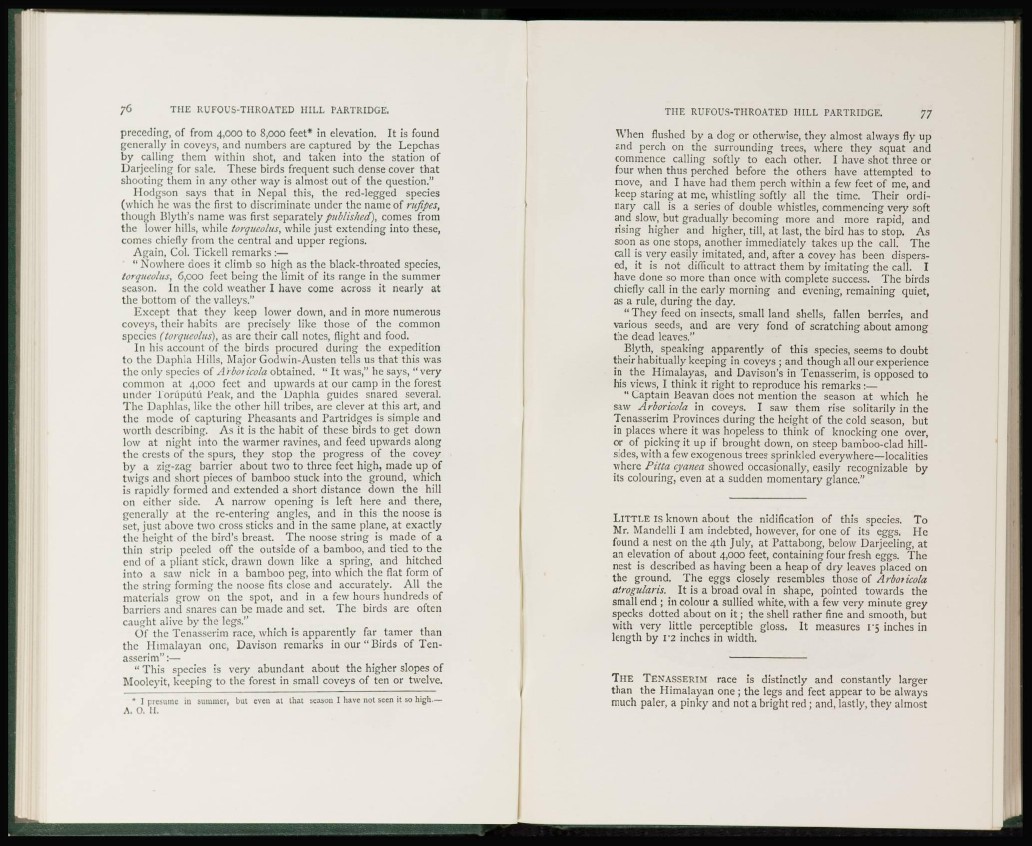
76 THE RUFOUS-THROATED HILL PARTRIDGE.
preceding, of from 4,000 to 8,000 feet* in elevation. It is found
generally in coveys, and numbers are captured by the Lepchas
by calling them within shot, and taken into the station of
Darjceling for sale. These birds frequent such dense cover that
shooting them in any other way is almost out of the question."
Hodgson says that in Nepal this, the red-legged species
(which he was the first to discriminate under the name of rufipes,
though Myth's name was first separately published), comes from
the lower hills, while torqueolus, while just extending into these,
comes chiefly from the central and upper regions.
Again, Col. Tickell remarks :—
" Nowhere does it climb so high as the black-throated species,
torqueolus, 6,coo feet being the limit of its range in the summer
season. In the cold weather I have come across it nearly at
the bottom of the valleys."
Except that they keep lower down, and in more numerous
coveys, their habits are precisely like those of the common
species (torqueolus), as are their call notes, flight and food.
In his account of the birds procured during the expedition
to the Daphia Hills, Major Godwin-Austen tells us that this was
the only species of Arboticola obtained. " It was," he says, "very
common at 4,000 feet and upwards at our camp in the forest
under Toruputu Peak, and the Daphia guides snared several.
The Daphlas, like the other hill tribes, are clever at this art, and
the mode of capturing Pheasants and Partridges is simple and
worth describing. As it is the habit of these birds to get down
low at night into the warmer ravines, and feed upwards along
the crests of the spurs, they stop the progress of the covey
by a zig-zag barrier about two to three feet high, made up of
twigs and short pieces of bamboo stuck into the ground, which
is rapidly formed and extended a short distance down the hill
on either side. A narrow opening is left here and there,
generally at the re-entering angles, and in this the noose is
set, just above two cross sticks and in the same plane, at exactly
the height of the bird's breast. The noose string is made of a
thin strip peeled off the outside of a bamboo, and tied to the
end of a pliant stick, drawn down like a spring, and hitched
into a saw nick in a bamboo peg, into which the flat form of
the string forming the noose fits close and accurately. All the
materials grow on the spot, and in a few hours hundreds of
barriers and snares can be made and set. The birds are often
caught alive by the legs."
Of the Tenasserim race, which is apparently far tamer than
the Himalayan one, Davison remarks in our "Birds of Tenasserim"
:—
" This species is very abundant about the higher slopes of
Mooleyit, keeping to the forest in small coveys of ten or twelve.
* I presume in summer, but even at that season I have not seen it so high.—
A. O. II.
THE RUFOUS-THROATED HILL PARTRIDGE. 77
When flushed by a dog or otherwise, they almost always fly up
and perch on the surrounding trees, where they squat and
commence calling softly to each other. I have shot three or
four when thus perched before the others have attempted to
move, and I have had them perch within a few feet of me, and
keep staring at me, whistling softly all the time. Their ordinary
call is a series of double whistles, commencing very soft
and slow, but gradually becoming more and more rapid, and
rising higher and higher, till, at last, the bird has to stop. As
soon as one stops, another immediately takes up the call. The
call is very easily imitated, and, after a covey has been dispersed,
it is not difficult to attract them by imitating the call. I
have done so more than once with complete success. The birds
chiefly call in the early morning and evening, remaining quiet,
as a rule, during the day.
" They feed on insects, small land shells, fallen berries, and
various seeds, and are very fond of scratching about among
the dead leaves."
Blyth, speaking apparently of this species, seems to doubt
their habitually keeping in coveys ; and though all our experience
in the Himalayas, and Davison's in Tenasserim, is opposed to
his views, I think it right to reproduce his remarks :—
" Captain Beavan does not mention the season at which he
saw Arboricola in coveys. I saw them rise solitarily in the
Tenasserim Provinces during the height of the cold season, but
in places where it was hopeless to think of knocking one over,
or of picking it up if brought down, on steep bamboo-clad hillsides,
with a few exogenous trees sprinkled everywhere—localities
where Pitta cyanea showed occasionally, easily recognizable by
its colouring, even at a sudden momentary glance."
L I T T L E IS known about the nidification of this species. To
Mr. Mandelli I am indebted, however, for one of its eggs. He
found a nest on the 4th July, at Pattabong, below Darjceling, at
an elevation of about 4,000 feet, containing four fresh eggs. The
nest is described as having been a heap of dry leaves placed on
the ground. The eggs closely resembles those of Arboticola
atrogularis. It is a broad oval in shape, pointed towards the
small end ; in colour a sullied white, with a few very minute grey
specks dotted about on i t ; the shell rather fine and smooth, but
with very little perceptible gloss. It measures 1*5 inches in
length by i'2 inches in width.
T H E TENASSERIM race is distinctly and constantly larger
than the Himalayan one ; the legs and feet appear to be always
much paler, a pinky and not a bright red ; and, lastly, they almost